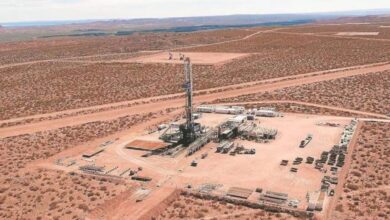Ancient Ocean Life Unearthed in Argentina’s Vaca Muerta Formation

Argentine paleontologists discover marine fossils in the Vaca Muerta formation. This critical finding opens a new perspective on ancient ecosystems that lasted millions of years.
Fossils Under the Andes
Once an ocean floor millions of years ago, Argentina’s desert-like Neuquén Province was forgotten until recent years. Within Neuquén, paleontologists have discovered fossils recovered from the Pampa Tril site, revealing fascinating life that once flourished within these long-lost oceans. Among the fossils they found were those of a marine crocodile skull and other creatures that once lived there, such as fish, oysters, and ammonites.
Today, the fossil site is within the famous oil and gas-harboring Vaca Muerta formation. However, these new discoveries point to an entirely different period in its history—150 million years ago, when the area was covered by the Pacific Ocean. It is evidence of a marine ingress, a period during which ocean waters flooded into the area and filled it with a variety of marine organisms.
The lead paleontologist with the Council for Scientific and Technical Research (CONICET) in Argentina, Mateo Gutiérrez, described the finding as remarkable. Specimens and, indeed, fossil marine life like these fills in the blanks when it comes to the diversity of marine life that once made its home on land in this part of the world.
Uncovering Fiscal Remains in the Layers of Vaca Muerta
Argentina has turned up many paleontological discoveries in the last few years, with the newest addition being a marine crocodile skull found in the sedimentary layers of Vaca Muerta by the team. Before this, the same team had found a vertebral column of an ichthyosaur, a dolphin-like marine reptile of the Jurassic period. This ichthyosaur, just a few kilometers from the new crocodile skull furt, indicates that those once waters were alive with diverse aquatic fauna.
While digging the site in the rocks of the Los Molles formation located in northern Neuquén, the paleontologists discovered bones of other sea animals. A vintage vent with a window into the region’s deep past, this sequence of rocks, 165 to 180 million years old, is another paleoenvironmental hotspot.
Gutiérrez said, “Vaca Muerta is known worldwide for its fossil fuels, but its richness in paleontology is just as impressive, showing ‘the whole world under the sea before the elevation of the Andes.'” The skulls and odd bits of bone might puzzle others, but to the team, each fossil provides another piece of what life was like under the ancient Pacific.
The Initial Marine Encroachments in the Neuquén Basin
Vertebrate fossils in Neuquén provide material relevant to a significant geological phenomenon: the documented marine transgression (from the Pacific Ocean) onto the infrastructure of the Neuquén Basin. About 165 million years ago, marine sediment layers rich in fossil remains signaled the expansion of the world ocean into Argentina today.
Fossils of ichthyosaurs—marine reptiles that adapted to life entirely in open water—were found in one of the fossil-rich regions close to where Chacay Melehue Creek runs. Over millions of years, these fish or dolphin-shaped creatures evolved to live entirely in the ocean. In contrast to much prehistoric life, ichthyosaurs adapted to live in the sea, boasting about flippers, dorsal fins, and streamlined bodies for moving quickly through the water.
Gutiérrez explains that the Los Molles formation contains signs of marine ingression and different marine fossils, “which are considered uncommon in Argentina.” Source: Gutiérrez “This is the first time the ichthyosaur has been documented from this site, further extending our understanding of its distribution.”
The team is now studying rock samples from Los Molles to date the fossils more precisely and characterize the environmental conditions that allowed this marine migration. Marine vertebrae and rib fragments from ichthyosaurs (giant marine reptiles) are occasionally discovered in these formations, according to Gutiérrez. However, the larger pieces of bone imply that much larger specimens await below the surface.
The Past, the Future, and a New Excursion to Reveal Ancient Life
These fossiliferous discoveries demonstrate the value of hydrocarbon-rich regions such as Argentina’s Vaca Muerta and Los Molles formations as powerful windows into ancient ecosystems. The fossilized bones and shells tell much of the story of ancient marine life that lived before the Andes rose to their present form when the region was still directly part of the ocean.
These discoveries give paleontologists such as Gutiérrez and his colleague Micaela Chaumeil Rodríguez of the Institute of Paleobiology and Geology insight into the anatomical variety of marine reptiles and other sea life that once swam these primordial seas. He points out that this highlights the fact that more excavations will be taking place, as there are bound to be more remains embedded in these formations.
There is little reason not to continue excavation work, Chaumeil Rodríguez said, as key in situ skeletons may be found. We have recovered some excellent specimens from the Vaca Muerta and Los Molles formations. Still, we think they have many more ancient world clues to give us.
Also read: Una nueva era para los eSports en América Latina: Liga de las Américas 2025
This discovery also emphasizes that, considering industrial exploration, measures must be taken to conserve fossil sites so Argentinian paleontological remains will be available for generations to come. By studying these rocks, researchers are reconstructing the worlds that existed in the Neuquén Basin and connecting them back to the world today.




